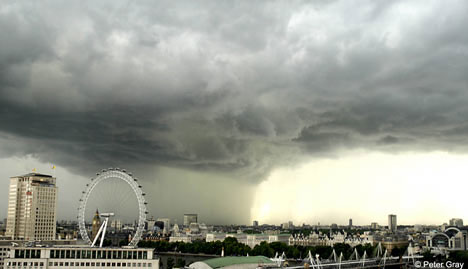Weather is insane. Or worse... Torrential rains in southeastern Spain in late September. Terrible tornadoes in the US in April. Extreme drought in California and Brazil. Wild fires in Europe (btw aggravated by cuts in public services). All this only in 2014 .... Because looking at the past years we still find many more extreme examples. Remember: In 2012, Hurricane Sandy was visiting New York. Tremendous flooding in Pakistan in 2010 that left hundreds of dead. Cyclone Nargis left more than 130,000 dead after passing through Birmania. The 2003 heatwave killed tens of thousands in Europe: in France alone almost 15,000 were calculated. Among others. (Not to mention earthquakes and tsunamis).
What's wrong with the weather? Is it really changing or is it just a coincidence? What does the climate change have to do in this? In 2014, which will probably be the warmest year on record, there is little doubt left about the existence of climate change. The question is whether climate events in the short term (such as extreme weather) can relate cause and effect via a complex phenomenon and, in the end, of long-term consequences such as global warming.
The Mexican Mario Molina, who shared the 1995 Nobel Prize in Chemistry for his work on CFCs and their effects on the ozone depletion, is very clear: "important changes have occurred in the scientific understanding of the extreme weather events [...]. They are now more clearly connected to human activities, such as the release of carbon dioxide ― the main greenhouse gas ― from burning coal and other fossil fuels "
%2B17.37.49.png) |
| Temperature Anomaly Distribution. Hansen et al. 2012 |
Hansen's article entitled "Perception of climate change" follows the same logic. Dr. James Hansen is the man who popularized the climate change in the political level, in 1988. He was in this period working in NASA and had enough outreach to talk to the US Congress (to an amazed Al Gore, who was in this period a congressman from Tennessee) about his conclusions on the subject: "the Global warming is now large enough that we can ascribe with a high degree of confidence a cause-and-effect relationship to the greenhouse effect." It was the start of a new era.
Hansen, as Molina, affirm we can see climate change modify our weather.
Hansen shows in this paper how the probability of unusually warm seasons has increased, specially in summer.
Hansen has studied the temperature anomalies in the period 1951-1980: a period when the global temperature was very stable, and is useful to compare. Their results show that the probability distribution (frequency of occurrence of temperatures) of local anomalies of the average temperature in the summer were following a normal distribution in the years 1950, 1960 and 1970 in both hemispheres. But each new decade, the distribution would have been flattened and shifted to positive anomalies, ie the zone of higher temperatures (he calls them "hot outliers").
When looking at standard deviations greater than 3, he observes that in 1950 there were 0.1% of the episodes of extreme heat and in 1980 there where 10%. This is 100 times more extreme heat events in 1980 than in 1950. The planet is heating and when it's warm, it is much much warmer.
The same occurs with cold events even if warm events are more frequent than cold ones.
In my opinion, the interesting thing here is that Hansen doesn't use a computer model of climate simulation. He statistically studied empirical data and explained what happened.
He explains successive heat waves that have occurred in recent years, specially in the northern hemisphere. The question is, why did that happen? It is clear that there is a correlation between global warming and increased presence of extreme events, but establishing a cause-effect relation is difficult and Hansen gets his feet wet. He literally says: “[...] we can state, with a high degree of confidence, that extreme anomalies such as those in Texas and Oklahoma in 2011 and Moscow in 2010 were a consequence of global warming because their likelihood in the absence of global warming was exceedingly small“. Perhaps too categorical... and of course, many scientists have disputed that statement.
This happened because it is very difficult to prove this relation. Weber established in 2010 these barriers to understanding climate change. There relation seems obvious, but ... Does that mean that if we successfully attack climate change, episodes of extreme weather will be reduced?
Maybe we just have to be more pragmatic... Munich Re, the biggest insurance company in the world speaks openly about the subject (advantages of not being a scientist).
Their NatCatSERVICE collects data from up to 1,000 natural disasters per year, which it studies and analyzes (worth to take a look). The chart below, shows that extreme natural phenomena have been almost tripled in 30 years.
At the end of 2011, Munich Re was talking about the report "Managing the Risks of Extreme Events and Disasters to Advance Climate Change Adaptation", or SREX. They said pretty much the same as Hansen but earlier: “It would seem that the growing number of weather- related catastrophes can only be explained by climate change. The view that weather extremes are more frequent and intense due to global warming is in keeping with current scientific findings“. And nobody complained.
Whether Hansen is wrong or not, there is something called the "precautionary principle" which is included in the Maastricht Treaty. It is simple:
"If a threat of serious or irreversible damage to the environment or human heath exists, a lack of full scientific knowledge about the situation should not be allowed to delay containment or remedial steps"
According to this principle, action needs to be taken.
Acting or not, that is the question...

%2B17.35.25.png)
%2B17.32.38.png)
No comments:
Post a Comment